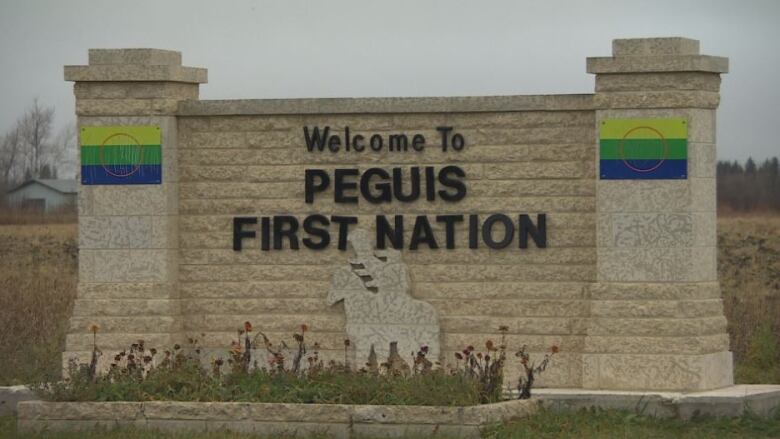How these 3 Manitoba First Nations are working together to fight COVID-19, keep spirits up this Halloween
Peguis and Fisher River First Nations were among earliest First Nations to see COVID-19 in Manitoba

Chiefs of some of the First Nations in Manitoba that were among the earliestto see cases of COVID-19 say collaboration is key in the face of rising cases, as the communities implement stricter measures to curb spread and seek safe ways to boost spirits.
"Jointly, the communities have a good discussion on how we can work together to limit the spread of COVID in our communities," said Chief David Crate of Fisher River Cree Nation, about 175 kilometres north of Winnipeg, between nearby Peguis and KinonjeoshtegonFirst Nations.
"The end goal, of course, is to try and stop the spread of COVID[within]our communities."
Fisher River and Peguis, about 20 kilometres south,saw their firstcases of COVID-19 in September. As of Monday, Fisher River had 12 active cases and 21 recoveries, for a total of 33 cases in the community, Crate said.
Since the first cases arose, Crate said he has workedclosely with Peguis Chief Glenn Hudson and Kinonjeoshtegon Chief David Traverse on restrictions in each community and how they'll affect the others. That's included virtual meetings with Hudson three times a week.
"The communities are actually side-by-side. That's been actually a difficult situation to manage,just because we're so closely connected, and we have people travelling back and forth between the communities," Crate said Tuesday. "We have fruitful discussions on how we can work together."
Those efforts have included consultations about upgrading each community to higher levels on the provincial colour-coded pandemic response system, and sharing public health resources such as contact tracers, said Peguis Chief Hudson on Tuesday.
Peguishas recently faced a sudden jump in cases numbers, he said, goingfrom zero active cases and 12 people in isolation on Oct. 19 to 28 active cases and 155 people in isolation by Oct. 23. The surge has strained the community's public health and contact tracing resources to the limit, he says.
His community has limited gathering sizes to five people andrestricted travel to neighbouring communities, except for emergencies or visits with immediate family.
It's also recommended the closureof non-essential services, brought in some curbside shopping options and redeployed someworkers to help withcontact tracing. Even teachers are being asked to contributeto thateffort, Hudson said.
Now, his community is in talks with Fisher River and Kinonjeoshtegonabout the impact of transitioning to a red, or "critical" pandemic response level, he said, including intermittent lockdowns that would last for three days at a time. Contact tracers from Fisher River may also pitch in to help in Peguis, he added.
"You could see that the community has been hit hard and that the virus does travel very, very fast," Hudson said.
"We are at a limit in terms of our resources, that being public health nurses, our contact tracing people and also our [checkpoint] security ... has been stretched very thin.'
'We'll celebrate this Halloween safely'
As concerns and cases rise, leaders in all three communities arefinding ways to boost community spirits and help members celebrate safely, including safer options for Halloween celebrations.
"It's just a tradition that we do here, although it is going to be a little bit different this year. But I'm hoping people are OK with that," said Kinonjeoshtegon'sChiefTraverse.
Instead of trick-or-treating, Kinonjeoshtegonis planning to distribute sanitized, pre-bagged candy and treats to members on Oct. 31, he said. The First Nation is also working on plans for a Halloween parade, with floats contributed by community organizations to fill the streets with festive fun in a different way than usual.
"We're not a very big community, but people do really come out Halloween night," Traverse said.
In Peguis, Hudson said plans are in the works for a Halloween yard-decorating contest, where families who want to compete can deck out their yards in spooky style. Prizes will be givento the top contenders, and there will becandy for all the kids.
They'll also set up a Halloween "theme park," Hudson said, so families can drive through and see festive decorations without leaving their vehicles.
"We're not going to allow people to travel out for Halloween outside of the community, or others to come in," Hudson said. "We'll celebrate this Halloween safely, and within the communityand our family bubbles."
Fisher River will also host a "safe Halloween," Crate said, inviting families to drive through or walk up to receive free, sanitized candy for their children.
They're working to offer a safe way to celebrate amid rising stress, Crate said.
"It's pretty mixed emotions here in the community," he said.
"Some people arecomfortable with all the requirements of staying home and reducing their interaction with other members. But I believe the stress level is probably high for a lot of people in the community."












_(720p).jpg)


 OFFICIAL HD MUSIC VIDEO.jpg)
.jpg)



























































































